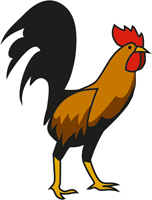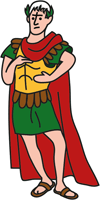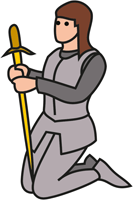< Introducing Northeast France
The History of France

The Gaulish chieftain Vercingetorix’s surrender to Julius Ceasar
The one theme that marks France’s past is the nation’s resilience – a tireless ability to bounce back from disasters. From being the most powerful country in Europe to fighting for survival and then rebuilding to attain its former glory, France has seen her fair share of ups and downs. But along with the wars and the revolutions also emerged ideals of chivalry, Gothic cathedrals, the metric system, the Declaration of the Rights of Man, pasteurization and modern art.
Prehistory to 121 BC
Humans have occupied France since around 2 million BC. Cro-Magnon Man is credited with the creation of great art at Lascaux and other Palaeolithic-era painted caves in southwest France. By 5000 BC, France was at the centre of the Neolithic civilization; Brittany saw the erection of the famous stones of Carnac.
The onset of the Bronze and Iron Ages around 1,500 BC brought in the Celts, or Gauls, who spread across the country in different tribes.
Roman Gaul
In 121 BC, the Romans took Marseilles, a Greek maritime colony, and pushed inland from there. Their new province is called Provence even today. The rest of Gaul fell to Julius Caesar, in a brilliantly-led six-year campaign (58–51 BC). Under the Romans, new cities, including Lugdunum (Lyon) and Lutetia (Paris), emerged, and imposing temples, forums and amphitheatres were built.
Christianity arrived in Gaul in the 3rd century. Under the Emperor Constantine, in 313, it became the principal religion of the Empire. At the same time, the Roman Empire was beginning its decline; its armies could no longer protect Gaul from barbarian invasions.
The Dark Ages
In 406, Germanic tribes crossed the Rhine frontier; the Visigoths settled in Tolosa (Toulouse) and the Burgundians founded Burgundy. The Franks set up base in the Seine river valley, now the Île de France. Politics and power became local affairs, although the Franks proved to be the most powerful: Clovis (482–511) conquered much of Gaul, Charles Martel stopped the Arab invasion in 732, and Charlemagne (768–814) seized most of Western Europe and was crowned Holy Roman Emperor by the pope. By 843, the empire was divided between Charlemagne’s grandsons. A period of invasions followed, notably from the powerful Vikings, who founded a state on the Channel – Normandy.
Medieval France
At the turn of the millennium, the first indications of an economic and cultural explosion could already be seen in Europe, with the Frankish Kingdom at its heart. Hugh Capet’s dynasty, established in 987, saw his descendants increase their royal domain bit by bit. In 1095, Pope Urban II declared the first of many crusades to the Holy Land, in all of which France played a leading role. In the 12th and 13th centuries, the Franks’ capital, Paris, emerged as Europe’s art and intellectual centre. Gothic architecture began to take the shape of grand cathedrals.
Meanwhile, England’s conquest by the Duke of Normandy in 1066 tied the two nations in war for years. In 1152, Henry II of Normandy wed Eleanor of Aquitaine and gained a mighty French duchy. The ensuing war between the kings of France and Henry II ended 60 years later, with victory for the French king, Philip II Augustus, who doubled the size of his realm.
The kingdom of France, however, signified only the north, the duchies of the south differing politically and culturally. But in 1209, the pope and Philip II Augustus led the Albigensian Crusade against the south, using the growing heresy of the Cathars there as a pretext, and absorbed the lands of the south into France’s realm.
End of the Middle Ages
By the 14th century, France was the most powerful country in Europe, but turmoil was about to strike. Edward III, king of England, laid claim to the French throne in 1337, and invaded in force, signalling the start of the Hundred Years’ War.
In 1347, France was devastated by the Black Death; millions died. Yet, the war continued. After victory at Agincourt in 1415, the English took Paris; they felt they had won. But the arrival of Joan of Arc in 1429 inspired the French to rise up. By 1453, they had recaptured all the English possessions, except Calais. France’s recovery was quick, and by the 1490s, they were at war again, this time in Italy. It was during this time that the artistic influence of the Italian Renaissance spread to the country. But more troubles were on the way. The Protestant Reformation divided the French, as many became Huguenots, or converts to the reformed faith of John Calvin. The nation was wrecked by the Wars of Religion which broke out in 1562, leading to many atrocities, including the six-day St Bartholomew’s Day massacre of Protestants in Paris. Finally, Henri IV fought his way to the throne and ended the war by decreeing religious tolerance with the Edict of Nantes in 1598.
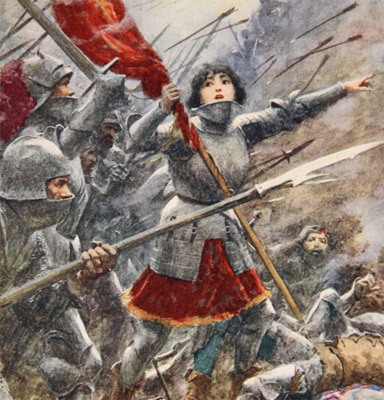
Joan of Arc leading her men against the English during the Hundred Years’ War
The Grand Siècle and Age of Enlightenment
After the assassination of Henri IV in 1610, four kings named Louis followed. The first, Louis XIII, ascended the throne very young. He was guided by Cardinal Richelieu, a powerful minister who transformed France into an absolute monarchy.
The 17th century is called France’s Grand Siècle (Grand Century). It reached its peak under King Louis XIV (1634–1715). He built the spectacular palace at Versailles. French music and Baroque architecture thrived. At the same time, the King’s endless wars nearly bankrupted France, while his misrule caused famines and revolts in the countryside. He also revoked the Edict of Nantes, leading to an exodus of Protestants from France.
In Louis XV’s reign (1715–74), 18th-century France entered an Age of Enlightenment. Philosophers such as Voltaire and Rousseau put forth ideas of equality and the inalienable rights of man – principles that went against the aristocratic order. But the nobility and church resisted change. Louis XVI ascend the throne in 1774 and attempted to pass some half-hearted reforms, but it was too late.
The French Revolution
Spurred by economic ills and ideas of equality, the French Revolution began when the king convened the Estates-General, the French parliament, in 1789. Tired of being disregarded, the Third Estate (commoners) broke away from the main body and declared itself a National Assembly of the People. They then swore to give France a constitution. With growing support, mobs gathered in Paris; on 14 July, they stormed the Bastille, seizing the royal fortress and its cache of arms.
The revolutionaries forced the monarchy to give France a proper constitution, but some wanted more change. In 1792, the First Republic was established and, in 1793, the royal family were executed by the newly invented guillotine. A Reign of Terror followed, marked by the massacre of thousands of people thought to be enemies of the Revolution. The resulting chaos set the scene for the rise of Napoleon Bonaparte.
Two Napoleons
Napoleon, as France’s leading general and strategist, went on to conquer and control much of Western Europe and even Egypt in the name of the Revolution. At the start of the 19th century, he took over France as First Consul. In 1804, he declared himself Emperor, and extended his empire. He carried out the reforms attempted by the revolutionaries, improving roads and education, establishing the metric system of measurement and freedom of religion. His reform of taxation and civil law, the Napoleonic Code, is still in use today.
Napoleon’s empire was constantly at war with other European countries. For years he seemed invincible, but in 1812 he invaded Russia. He captured Moscow, but was unable to defeat the Russian armies. In 1814, Napoleon was deposed and exiled to Elba, but escaped to seize power yet again before his reign finally ended at the Battle of Waterloo in 1815.
After Napoleon, the Bourbon monarchs were restored under Louis XVII, but France’s turbulent politics led to another revolution in July 1830. This resulted in a constitutional monarchy under King Louis-Phillipe. France began to modernize, but Parisians, in particular, were still dissatisfied, and in 1848 yet another revolution led to a Second Republic. It elected Napoleon’s nephew as its president. He soon proclaimed himself Emperor Napoleon III. His “Second Empire” was marked by the remaking and modernization of Paris. In the war of 1870, Prussia and other German states overran northern France and besieged Paris. The armistice terms left Parisians humiliated. Riots led to the creation of the Paris Commune, which was brutally crushed by the French Army.
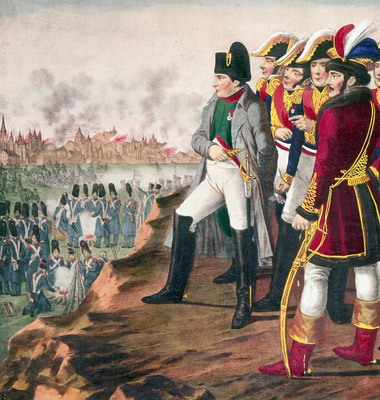
Napoleon and his officers watch the burning of Moscow in 1812
The Third Republic
France finally found political stability under the Third Republic. The new regime passed long-needed reforms in education and social welfare, but political agitation still rocked the Republic. This period is also referred to as the belle époque (Beautiful Era), known for its Art Nouveau style and technological advancements.
Around 1.7 million Frenchmen and women died during World War I, and large parts of the country were devastated. The exhausted nation was slow to recover. The avant-garde 1920s saw the arrival of Art Deco, experimental writers, Surrealism and jazz. The grim 1930s were a time of depression and the threat of war. France was invaded once again in 1940. Northern France fell under a bitter Nazi occupation; the south, left alone for a while under the Vichy regime, was occupied in 1942. A strong resistance network aided the liberation, and Free French troops entered Paris in August 1944.
France since 1945
The nation struggled to regain its bearings under an unstable Fourth Republic of squabbling politicians and short-lived governments. More trouble came in the form of colonial liberation movements; France lost both Vietnam and Algeria after years of fighting. In 1958, General Charles de Gaulle was established President, and constituted the Fifth Republic.
Angry with social restrictions and an inflexible state, students and workers came together in 1968 in a revolt that demanded political and economic change. De Gaulle restored order once more. Since then, France has become a more open society.
Today, France is a prosperous and egalitarian society. Its innovative technologies have caught the world’s imagination. With a rich cultural heritage, the country attracts nearly 80 million foreign visitors a year.
Facts & Figures
The rooster emblem
Gallus, in Latin, can mean either a Gaul or a chicken. In the Middle Ages, the enemies of the country joked that the French were as proud and feisty as roosters. Instead of being insulted, the French made the coq a national emblem – you will often see them carved on top of war memorials.
Politics vs cheese
President Charles de Gaulle gave the best explanation for French politics, “How can anyone govern a country that makes 246 different kinds of cheese”? In fact, there may be more than a thousand!
Riding the bus
In 1662, mathematician and philosopher Blaise Pascal gave Paris the world’s first city bus - a horse-drawn carriage. It was a big success, until common people were banned from using it.
The “humane” guillotine
The “national razor” or the guillotine of the Revolution was actually meant as a more humane means of execution. It was still being used as late as 1977.
More perfume please
The French nobility during the reign of Louis XIV believed that washing was bad for them. So they never did! They just piled on more perfume and powder.
Name that pig
In France, it is against the law to name your pig Napoleon.
What did you say?
In 1880, only a quarter of the French spoke French as their native language.
Heroes & Villains
Julius Caesar
If he had really met Asterix and Obelix, he would have probably had their heads chopped off or sold them into slavery.
Philip II Augustus
The first to call himself “King of France”. He built the nation, defeated all its enemies and doubled the size of the kingdom.
Joan of Arc
A simple girl who put on armour and rode into battle with thousands of soldiers to drive the English out of France.
Henri IV
Popularly known as “Our Good King Henry”, he made his people stop quarrelling over religion and wanted each family to have a chicken for the pot each Sunday.
Voltaire
Devoted his pen and his life to the cause of liberty. He was thrown in jail more than once. He got his revenge by showing the French how to laugh at themselves.
Maximilien Robespierre
Thought he was the purest, most virtuous man in France – he sent 40,000 people who disagreed to the guillotine!
Napoleon Bonaparte
The story of this young, dashing general makes for an exciting chapter in history. But 1,800,000 Frenchmen died for his ambitions and dreams of glory.
Charles de Gaulle
A brilliant general who picked up a tired and defeated nation and gave it back its courage. Later, he came out of retirement to save it again as the president of the country.




